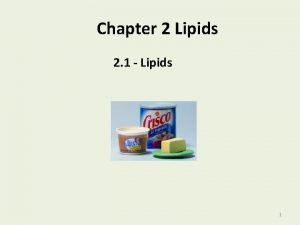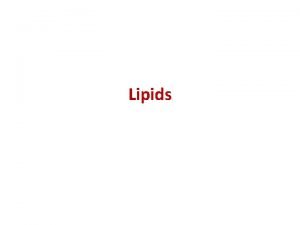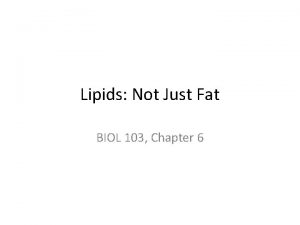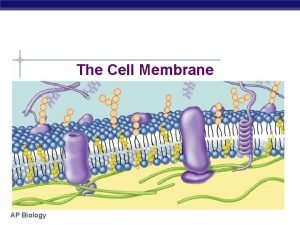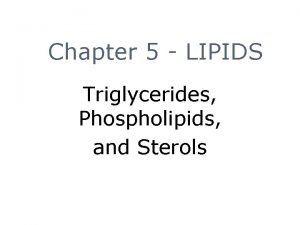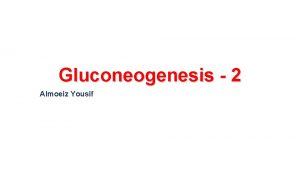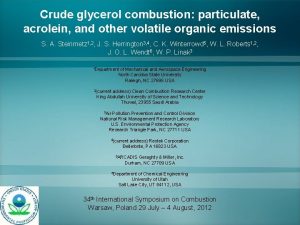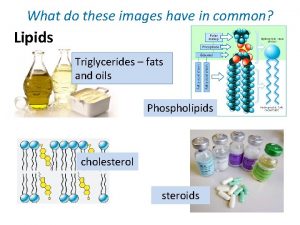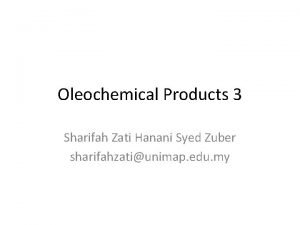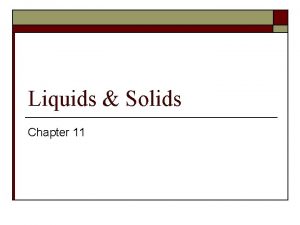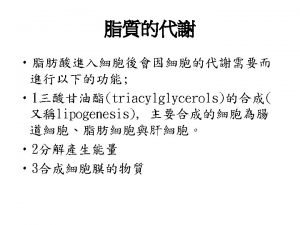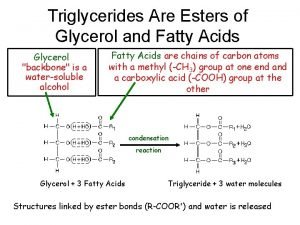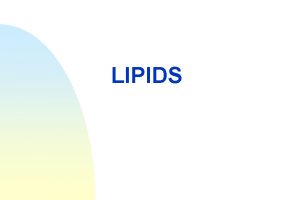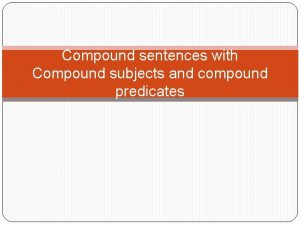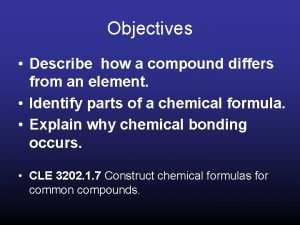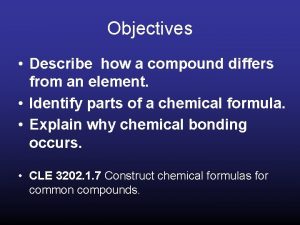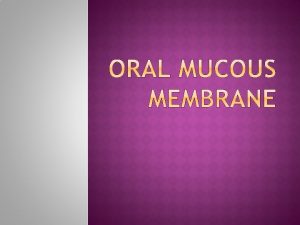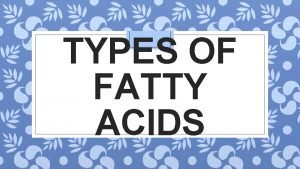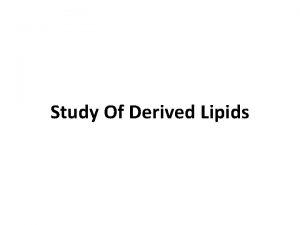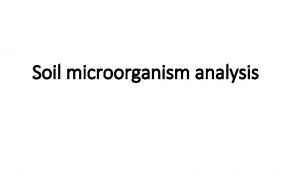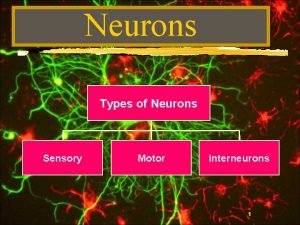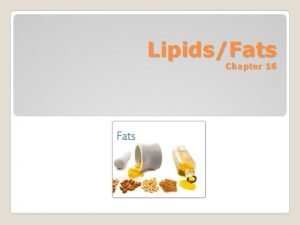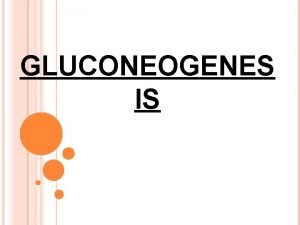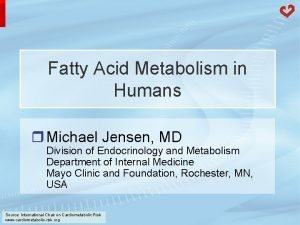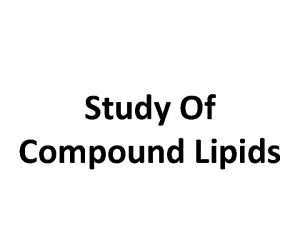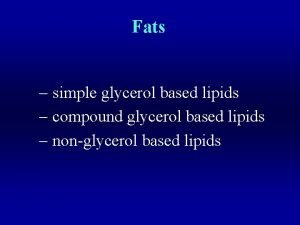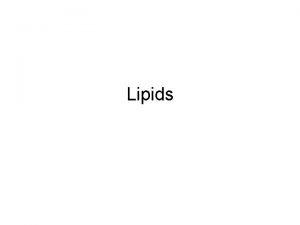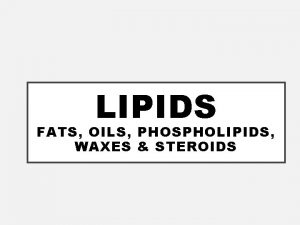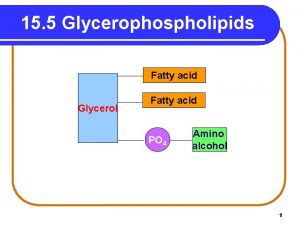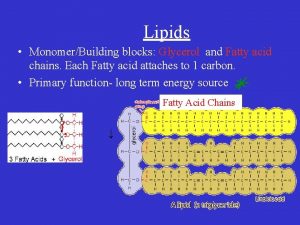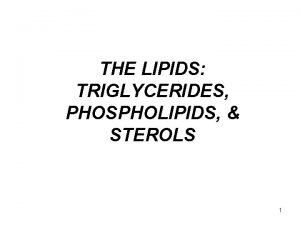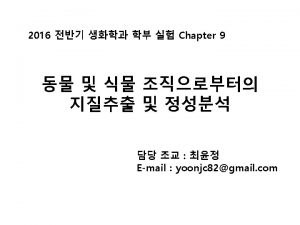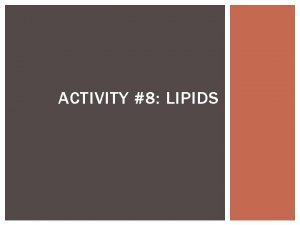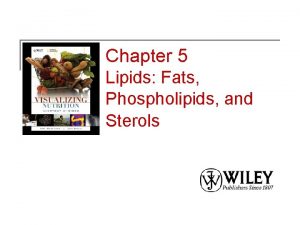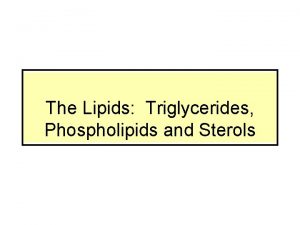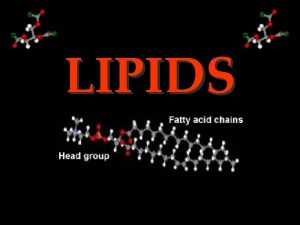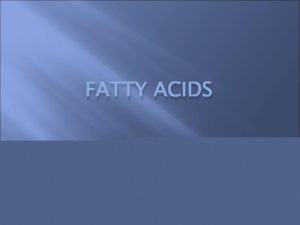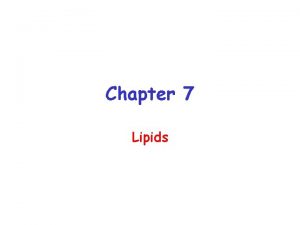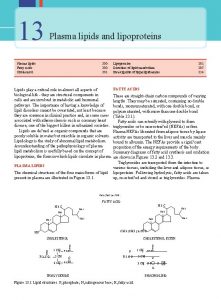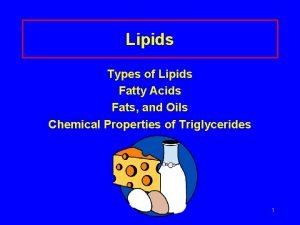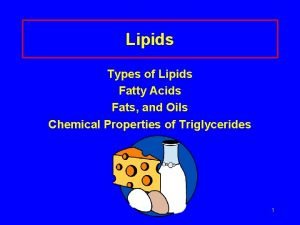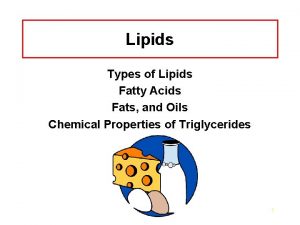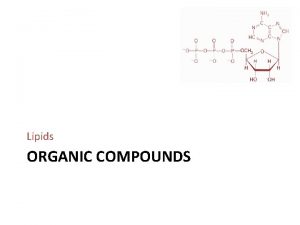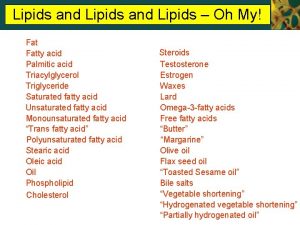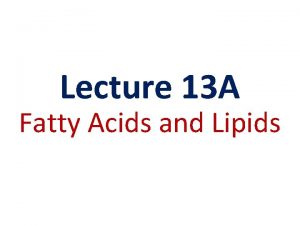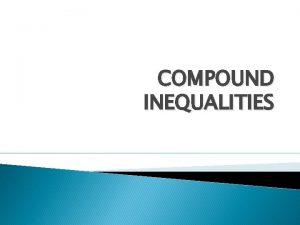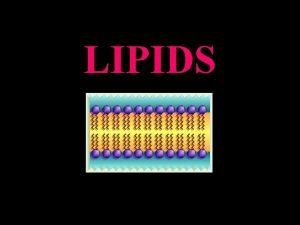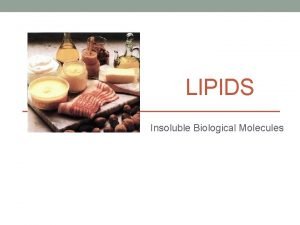2 Compound lipids a Phospholipids Glycerol two fatty


































- Slides: 34

2. Compound lipids: a. Phospholipids Glycerol + two fatty acids + phosphorus l Phosphorus part makes it soluble in water l Fatty acids make it soluble in fat l Therefore can serve as an emulsifier l Key role is in cell membranes l They are the next largest lipid component of the body after triglycerides l

2. Compound lipids: Phospholipids • They are l l l function in maintaining the structural integrity of the cell rather than as fat store Component of cell membranes Phospholipids combine with protein in cell membrane where they act as a liaison between fat –soluble and water –soluble substances that facilitate the passage of fat in and out of the cell so they act as carriers in the active transport systems Lipid transport as part of lipoproteins In extreme starvation the phospholipids content remains fairly constant , thus maintains the integrity of tissue cells

Cell membranes are phospholipid bilayers

i. Glycerophospholipids (Lecithin & Cephalin) Lecithins • • • are the most widely distributed of the phospholipids Lecithin is made by the body in biomembrane and is widely distributed in food supply like liver , egg yolk , soybeans , peanuts , legumes and raw vegetable oils such as corn oil. Lecithin is a major component of the high – density lipoprotein (HDL) which is used to remove cholesterol from the cell membrane Lecithin is added to food products such as cheese to aid in emulsification Animal products are sources of lecithin because all animal cells contain lecithin as a lipid bilayer components Cephaline is needed to form thromboplastin for the blood clotting process. Egg yolk and liver are good sources

ii. Glycosphinolipids (Sphingomyeline) • Is found in the brain and other nerve tissue as a component of the myelin sheath. • Sphingomyelin acts as an insulator around the nerve fibers • Egg yolk and liver are good sources

2. Compound lipids: b. Glycolipids ( Cerebrosides & Gangliosides ) • Glycolipids contain the base sphingosine and fatty acids with 22 and 24 carbons. • The carbohydrate component of cerebrosides is galactose • The gangliosides contain in addition , glucose and a complex compound containing an amino sugar. • Structurally both cerebrocides and gangliosides are copmonents of nerve tissue and certain cell membrane where they play a role in fat transport

2. Compound lipids: c. Lipoproteins l l l Lipoprotein are formed primarily in the liver and are found in cell and organelle mitochondria and lysosome. Transport vehicles for fat in the lymph and blood systems. Lipoprotein are classified as; - Chylomicrons – – – Very Low Density Lipoprotein (VLDL) Low Density Lipoprotein (LDL) High Density Lipoprotein (HDL)

3. The Sterols (Steroids) l Cholesterol is the major representative of Sterols l Not an essential nutrient it can be obtained from diet and can be made by the body l Cholesterol has 2 sources: made in liver and from food l Found only in animal foods

3. The Sterols (Steroids) Cholesterol Functions l Component of cell membranes l Precursor to other substances l Precursor for making steroid hormones l Vitamin D and sex hormones are also sterols l Precursor for making bile

Blood cholesterol forms HDL (“good cholesterol”) – takes cholesterol away from the tissues (physical activity increases HDL) l LDL (“bad cholesterol”) – carries cholesterol to tissues (associated with artery blockage) l


Chylomicrons. l The just-eaten fat travels in the bloodstream as chylomicrons. l Body tissues can extract whatever fat they need from chylomicrons. l The remnants are then picked up by the liver, which dismantles them and reuses their parts.

Chylomicron: travels via the Lymphatic System l l Think of a chylomicron as a tennis ball. The water fearing or hydrophobic fats are in the inside of the tennis ball. The fuzzy yellow part of the ball represents the hydrophillic or water loving part. l Chylomicrons are phospholipids that can travel via the lymphatic system. l The second picture depicts a hydrophilic and hydrophobic membrane. Hydrophilic head Hydrophobic tail

Major Lipoproteins: VLDL, HDL l In addition to the chylomicron, the body uses three other types of lipoproteins to carry fats: l Very-low-density lipoproteins (VLDL), which carry triglycerides and other lipids made in the liver to the body cells for their use. l Low-density lipoproteins (LDL) transport cholesterol and other lipids to the tissues. LDL are made from VLDL after they have donated many of their triglycerides to body cells. l High-density lipoproteins (HDL), which are critical in the process of carrying cholesterol away from body cells to the liver for disposal.

Major Lipoproteins: VLDL, HDL and LDL play major roles with regard to heart health and are the focus of most recommendations made for reducing the risk of heart disease. l Which lipoprotein do you want to have more of? l Answer: HDL

Major Lipoproteins: VLDL, HDL

The LDL and HDL Difference l l LDL – larger, lighter, and richer in cholesterol. Delivers cholesterol and triglycerides from the liver to the tissues. l LDL – Less healthy HDL – smaller, denser, and packaged with more protein. HDL scavenge excess cholesterol and phospholipids from the tissues for disposal. l HDL - Healthy

What Does Food Cholesterol Have to Do With Blood Cholesterol? Saturated food fats (and trans fat) raise blood cholesterol more than food cholesterol does. l Dietary cholesterol makes a smaller but still significant contribution to elevated blood cholesterol. l. A small percentage of people respond to a high cholesterol intake with greatly increased blood cholesterol. l

Lipoproteins and Heart Disease Risk Once digested, saturated fats and trans fats are packaged by the liver into LDLs. l Saturated and trans fats increase blood cholesterol l The circulating LDLs adhere to sticky places along the walls of blood vessels causing a buildup of plaque. The plaque can then narrow the blood vessel restricting blood flow to the heart l

Lipoproteins and Heart Disease Risk Elevated LDL concentration in the blood is an indication of heart attack risk* l Elevated HDL concentration in the blood is associated with a low heart attack risk l The difference is due to the proportions of lipids they contain and the tasks they perform The difference is not in the type of cholesterol they carry l

Cholesterol Plaque Cholesterol forms the major parts of the plaques that narrow arteries in atherosclerosis The underlying cause of heart attacks and strokes

Lowering LDL Cholesterol To lower LDL Reduce saturated fat l Reduce trans fat l Substitute monounsaturated or PUFA l Eat cholesterol in moderation l Soluble fiber intake l People respond differently to dietary means of controlling blood lipids. l


Fats to Avoid: Saturated Fats and Trans Fats l The number one dietary determinant of LDL cholesterol is saturated fat.




Lowering LDL Cholesterol LDL is susceptible to oxidation which may trigger some of the damage to the arteries of the heart. l Adequate intakes of dietary antioxidants* may oppose LDL oxidation. * Vitamin C, vitamin E, selenium, and some phytochemicals l

Lowering LDL Cholesterol

Lowering LDL Cholesterol

What Are Some Ways To Control Blood Cholesterol and Triglycerides? l Healthy Eating l Physical Activity l Weight Loss l Medication


Good Fat vs. Bad Fat What Makes a Fat “Good”? Unsaturated fats: lower cholesterol l Unsaturated fats include most plant fats l Vegetable oils, olives, avocadoes, nuts and seeds are made up of mostly unsaturated fats l Replacing bad fats with these good fats can lower your blood cholesterol l

What Makes a Fat “Bad”? l l Saturated fats increase cholesterol Fats that are hard at room temperature are mostly saturated Animal fats tend to be more saturated than plant fats Hydrogenation also makes fats more saturated
 Steroid nucleus structure
Steroid nucleus structure Classification of lipids
Classification of lipids Examples of phospholipids in food
Examples of phospholipids in food Chapter 3 cells and tissues figure 3-1
Chapter 3 cells and tissues figure 3-1 Cell membrane phospholipids
Cell membrane phospholipids Phospholipids
Phospholipids Phospholipids
Phospholipids Triglycerides phospholipids and sterols
Triglycerides phospholipids and sterols Glycerol to glucose
Glycerol to glucose Glycerol to glucose
Glycerol to glucose Specific weight to density
Specific weight to density Glycerol combustion
Glycerol combustion Cholesterol glycerol
Cholesterol glycerol Surfactant examples
Surfactant examples Viscosity of glycerol
Viscosity of glycerol Triacylglycerol cycle
Triacylglycerol cycle Glycerol and palmitic acid reaction
Glycerol and palmitic acid reaction Definition of lipids
Definition of lipids Complex lipids
Complex lipids Pauline and bruno have a big argument
Pauline and bruno have a big argument Simple and complete predicate
Simple and complete predicate Compound complex simple sentences quiz
Compound complex simple sentences quiz Compound predicate sentences
Compound predicate sentences A compound differs from an element in that a compound
A compound differs from an element in that a compound A compound differs from an element in that a compound
A compound differs from an element in that a compound Fatty zone of hard palate
Fatty zone of hard palate Invisible fat examples
Invisible fat examples Nomenclature of saturated fatty acids
Nomenclature of saturated fatty acids Phospholipid fatty acid analysis soil
Phospholipid fatty acid analysis soil Fatty casing that helps speed neurotransmission
Fatty casing that helps speed neurotransmission What are triglycerides
What are triglycerides Characteristics of lipids
Characteristics of lipids Gluconeogenesis
Gluconeogenesis Fatty acid synthesis
Fatty acid synthesis Fatty acid oxidation
Fatty acid oxidation
